Unit 8 Literature Lesson 1 The Last Leaf 课件(共51张,内嵌音频)2024-2025学年高二英语北师版(2019)选择性必修3
文档属性
| 名称 | Unit 8 Literature Lesson 1 The Last Leaf 课件(共51张,内嵌音频)2024-2025学年高二英语北师版(2019)选择性必修3 |
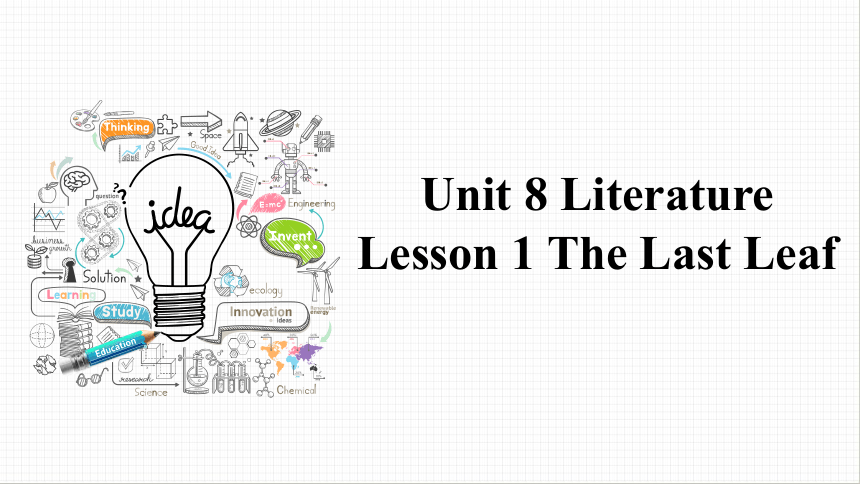
|
|
| 格式 | pptx | ||
| 文件大小 | 19.8MB | ||
| 资源类型 | 教案 | ||
| 版本资源 | 北师大版(2019) | ||
| 科目 | 英语 | ||
| 更新时间 | 2025-05-02 09:57:42 | ||
图片预览

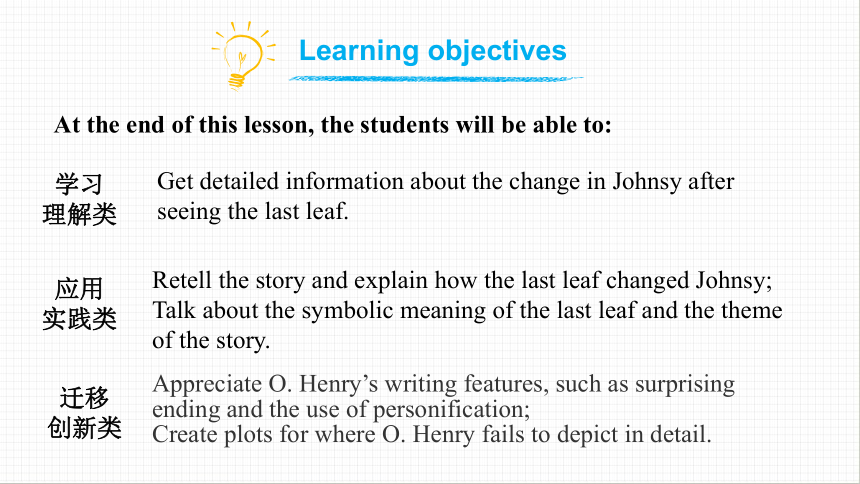
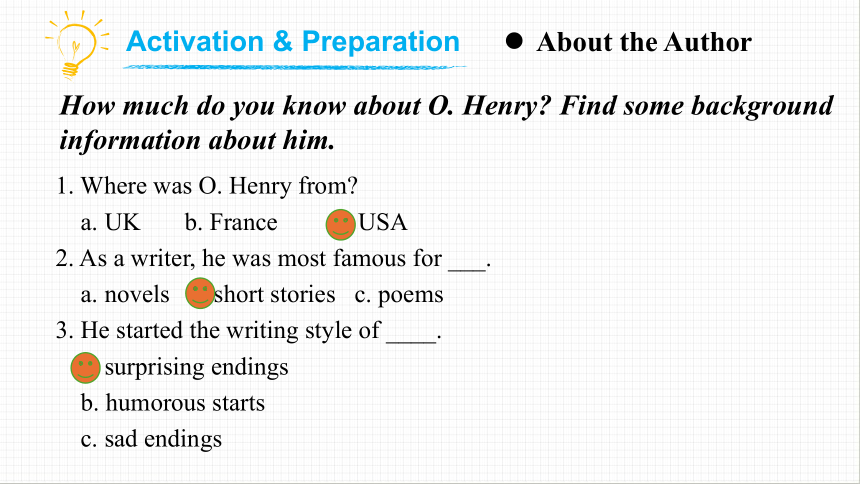
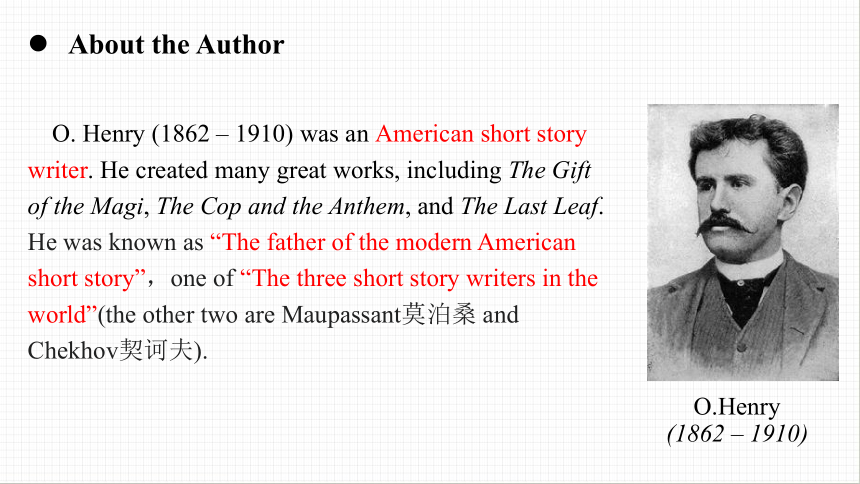
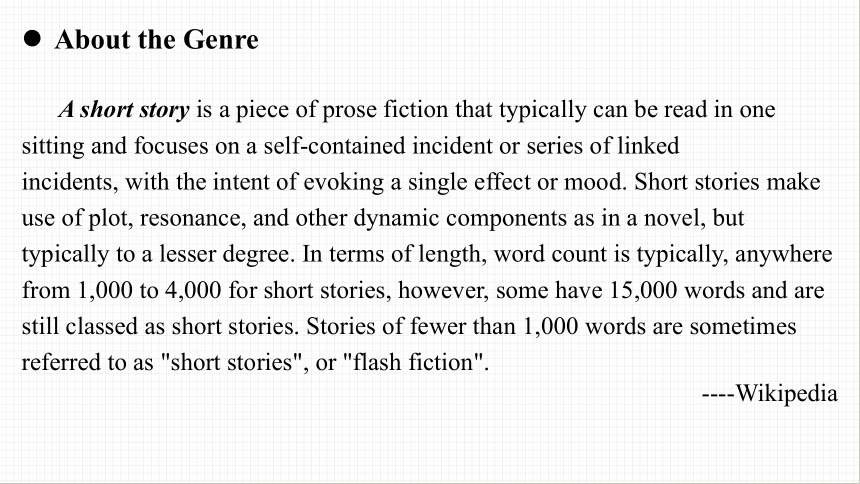


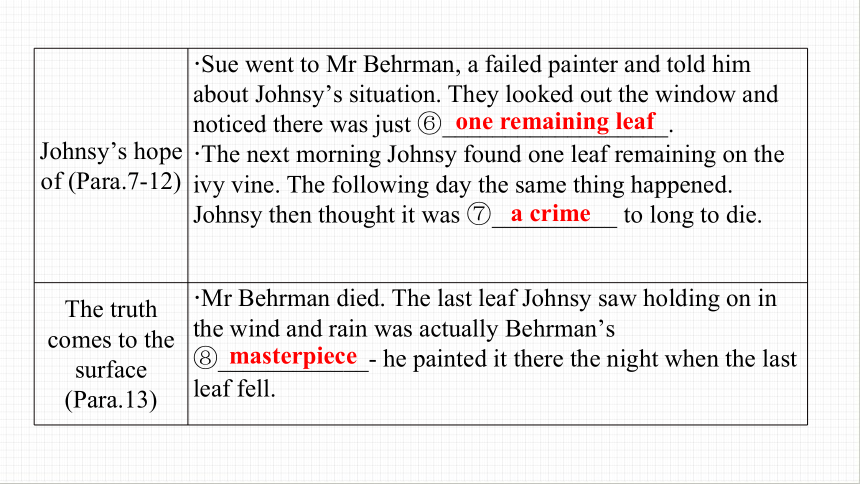
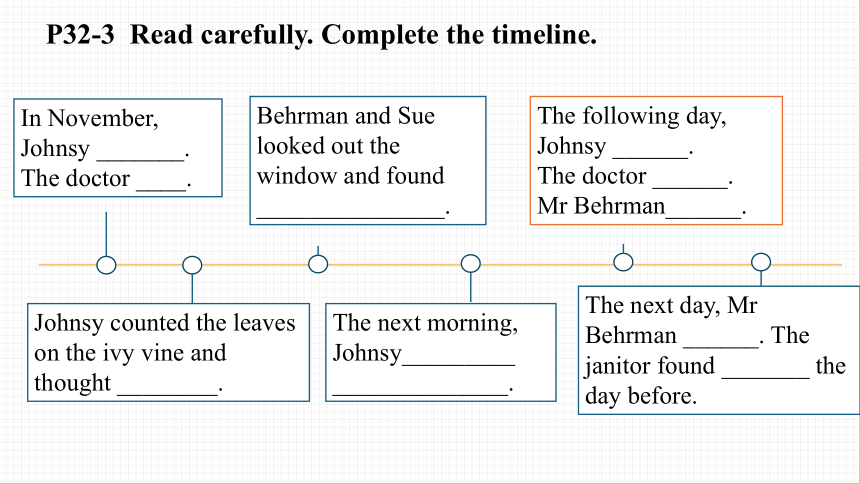

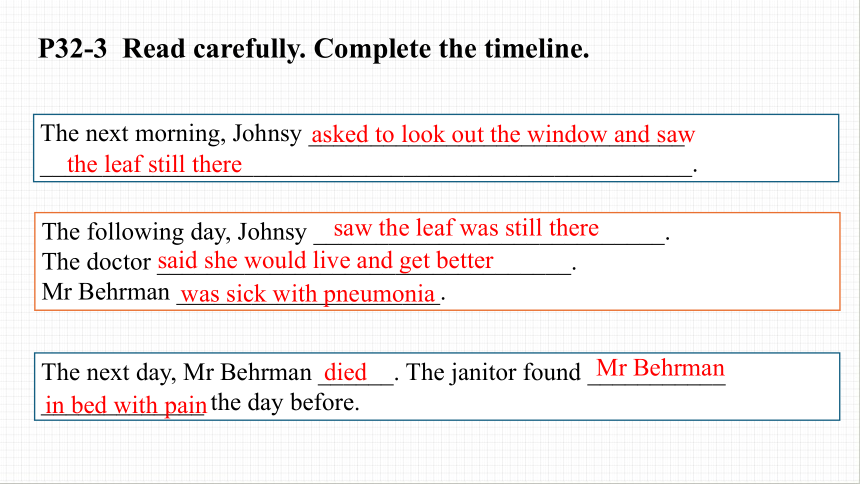
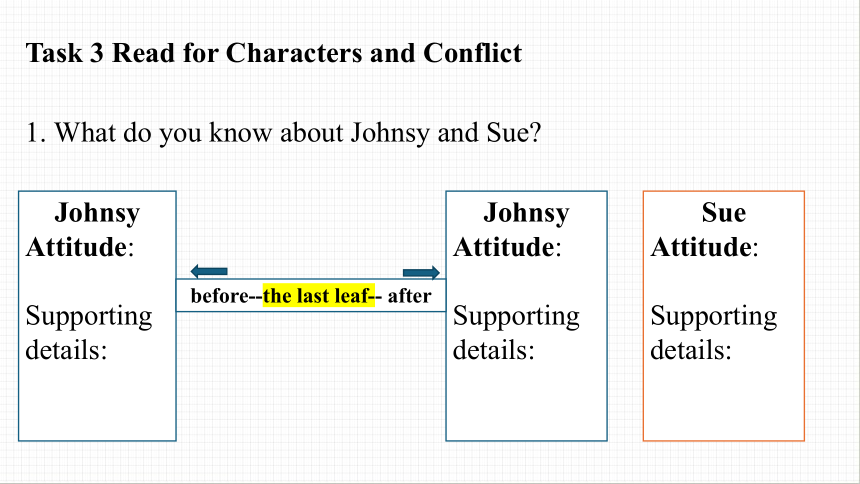
文档简介
(共51张PPT)
Unit 8 Literature
Lesson 1 The Last Leaf
At the end of this lesson, the students will be able to:
学习
理解类
应用
实践类
迁移
创新类
Get detailed information about the change in Johnsy after seeing the last leaf.
Retell the story and explain how the last leaf changed Johnsy;
Talk about the symbolic meaning of the last leaf and the theme of the story.
Appreciate O. Henry’s writing features, such as surprising ending and the use of personification;
Create plots for where O. Henry fails to depict in detail.
Learning objectives
How much do you know about O. Henry Find some background information about him.
1. Where was O. Henry from
a. UK b. France c. USA
2. As a writer, he was most famous for ___.
a. novels b. short stories c. poems
3. He started the writing style of ____.
a. surprising endings
b. humorous starts
c. sad endings
Activation & Preparation
About the Author
O.Henry
(1862 – 1910)
O. Henry (1862 – 1910) was an American short story writer. He created many great works, including The Gift of the Magi, The Cop and the Anthem, and The Last Leaf. He was known as “The father of the modern American short story”,one of “The three short story writers in the world”(the other two are Maupassant莫泊桑 and Chekhov契诃夫).
About the Author
About the Genre
A short story is a piece of prose fiction that typically can be read in one sitting and focuses on a self-contained incident or series of linked
incidents, with the intent of evoking a single effect or mood. Short stories make use of plot, resonance, and other dynamic components as in a novel, but typically to a lesser degree. In terms of length, word count is typically, anywhere from 1,000 to 4,000 for short stories, however, some have 15,000 words and are still classed as short stories. Stories of fewer than 1,000 words are sometimes referred to as "short stories", or "flash fiction".
----Wikipedia
Task 1 Text structure
Main characters
1._______→a patient
Sue
Behrman→a painter
Time
in 2._________
Place
in Greenwich Village
The development
of the story
Johnsy was 3._____ badly.
She counted the 4._________ out the window.
She thought she must go when the last leaf 5.______.
Three days later the last leaf remained on the vine.
The ending
of the story
The last leaf was 6.____________ on the wall by Behrman. But he died.
The
last
leaf
Johnsy
November
ill
leaves
fell
painted
↓
↓
↓
Reading & Understanding
Task 2 Read the whole passage and complete the table.
The background of the story (para.1-2) ·Time: in ①__________
·Place: Greenwich Village (The art people came together)
·Character: Sue and Johnsy having their ②__________
·Setting: Johnsy was affected with Pneumonia.
Johnsy is dying (Para.3-6) ·The doctor claimed that Johnsy had only 10% chance to live. Thinking ③______________ thought about the future and living may be helpful.
·Sue drew in Johnsy’s room and attempted to ④____________________. Johnsy counted backwards the left leaves on the ivy vine, thinking she would die when the last leaf ⑤__________.
November
studio
more hopeful
raise Johnsy’s spirits
fell
Johnsy’s hope of (Para.7-12) ·Sue went to Mr Behrman, a failed painter and told him about Johnsy’s situation. They looked out the window and noticed there was just ⑥__________________.
·The next morning Johnsy found one leaf remaining on the ivy vine. The following day the same thing happened. Johnsy then thought it was ⑦__________ to long to die.
The truth comes to the surface (Para.13) ·Mr Behrman died. The last leaf Johnsy saw holding on in the wind and rain was actually Behrman’s ⑧____________- he painted it there the night when the last leaf fell.
one remaining leaf
a crime
masterpiece
P32-3 Read carefully. Complete the timeline.
In November, Johnsy _______.
The doctor ____.
Johnsy counted the leaves on the ivy vine and thought ________.
Behrman and Sue looked out the window and found _______________.
The following day, Johnsy ______.
The doctor ______.
Mr Behrman______.
The next morning, Johnsy_________ ______________.
The next day, Mr Behrman ______. The janitor found _______ the day before.
________________________________________________________
In November, Johnsy _____________________.
The doctor _______________________.
Behrman and Sue looked out the window and found _______________.
Johnsy counted the leaves on the ivy vine and thought _______
___________________________________________________.
that she must die when the last leaf falls
got sick with pneumonia
said she might not get better
one leaf left
n. 肺炎
P32-3 Read carefully. Complete the timeline.
The following day, Johnsy ____________________________.
The doctor _________________________________.
Mr Behrman _____________________.
The next morning, Johnsy ______________________________
____________________________________________________.
The next day, Mr Behrman ______. The janitor found ___________ _____________ the day before.
asked to look out the window and saw
the leaf still there
saw the leaf was still there
said she would live and get better
was sick with pneumonia
died
Mr Behrman
in bed with pain
P32-3 Read carefully. Complete the timeline.
1. What do you know about Johnsy and Sue
Task 3 Read for Characters and Conflict
Johnsy
Attitude:
Supporting details:
Sue
Attitude:
Supporting details:
Johnsy
Attitude:
Supporting details:
before--the last leaf-- after
1. What do you know about Johnsy and Sue
Johnsy: desperate and pessimistic before the last leaf
She believed it was her fate命运 to be dying.
Task 3 Read for Characters and Conflict
1. What do you know about Johnsy and Sue
Johnsy: inspired and optimistic after the last leaf
Task 3 Read for Characters and Conflict
She understood it was wrong to give up life and hope.
1. What do you know about Johnsy and Sue
Sue: supportive,
caring and helpful,
Task 3 Read for Characters and Conflict
2. What kind of person was Mr. Behrman
He was a failed painter, yet aspiring.
He was kind-hearted and compassionate富有同情心的.
He found it was his obligation义务 to take care of his neighbours.
Task 3 Read for Characters and Conflict
What did the last ivy leaf mean
1.to Behrman A. a thread
2.to Johnsy B. a masterpiece
3.to plot C. a symbol of hope of life
Interpretation & Inspiration
Discuss and answer the questions.
What does Sue’s comment “it (the painting of the last leaf) is Behrman’s masterpiece” mean
It was painted true to life栩栩如生 that Johnsy didn’t even find it was a picture.
It was the best art he ever painted because it kept Jonhsy hopeful and alive.
Interpret “the last leaf” for inspirations
2.What does the last leaf symbolize
3. What do you think the story is trying to express
The story is trying to express how people love and take care of each other. It also invites readers to think about attitudes towards life.
“O. Henry ending” usually refers that at the end of the novel the character's mind suddenly changes, or the twist of fate happens. The ending is unexpected, yet reasonable, resulting in a unique artistic charm.
O.Henry Ending
Appreciate writing features –the ending
The ending indicates Mr. Behrman’s kind deeds.
Leave readers some space to imagine what he had gone through on such a terrible night.
How do you like the ending of the story Do you find it surprising/ reasonable
Appreciate writing features –the ending
2. How does the author describe pneumonia Why does he describe pneumonia in this way
In order to make pneumonia scary
Personification
Appreciate writing features – figurative language
P32—7 In the story, the writer uses different words to express similar meanings Read the story and write them down. Then work in pairs and use each word to describe a scene.
say:___________________________________
claim, ask, reply, cry, tell
see:___________________________________
die:___________________________________
look, watch, stare, notice
go, go sailing down, go away, slip away
Quiz
"The Last Leaf" is a beautiful short story written by O. Henry. In the story, the two main characters, Johnsy and Sue, lived in a studio apartment in a
1. building. The author describes the illness "pneumonia" as a person who placed an 2. finger on Johnsy making her terribly ill. She lay in bed under a 3. looking 4. at the wall. The doctor took Sue 5. and told her that Johnsy had only a small chance of surviving the illness.
Finish the practice 1 on page 46.
icy slip stare fetch blank
aside curtain three-story blanket backwards
three-story
icy
blanket
blankly
aside
Sue noticed that Johnsy wasn't 6. at the wall but was actually looking out the window at leaves on an ivy vine and counting 7. .She said they had been falling for days and when the last one fell, she would die.
Sue went to 8. her neighbor Mr Behrman and told him what Johnsy said about wanting to 9. away like the leaves. Mr Behrman said that was nonsense.
The next morning, Johnsy asked Sue to open the 10. and found that the last leaf remained on the vine, despite the rain and snow having fallen all night.
Johnsy came to realise her foolish thought and started to become healthier.
However, Mr Behrman died from pneumonia. In a snowing and raining night, he painted his masterpiece --- a vine leaf on the wall outside of Johnsy's window.
staring
backwards
fetch
slip
curtains
icy slip stare fetch blank
aside curtain three-story blanket backwards
Text Reading
课文学习
第二部分
1. Greenwich Village is a place where the art people came together, hunting for apartments with north-facing windows and low rents. At the top of a three-story building, Sue and Johnsy had their studio.
先行词
关系副词引导定语从句
现在分词做伴随状语
面朝北方的
n.租金 v.租赁
n.故事;楼层
画室
格林威治镇是个艺术人士聚集的地方,他们在那里寻找窗户朝北且租金低廉的公寓。苏和约翰西的画室就在一座三层楼的顶楼。
寻找
在……的顶部
聚集
2. In November, a cold, unseen stranger, whom the doctors called Pneumonia, arrived in Greenwich Village. Mr Pneumonia placed his icy finger on Johnsy; and she lay, barely moving, in her bed staring at a blank wall under her blanket.
先行词
关系代词whom引导的非限定从
凝视:现在分词做伴随状语
十一月的时候,一个冷酷无情、肉眼看不见、医生称之为“肺炎”的不速之客,来到了格林威治村。“肺炎先生”把他冰冷的手指放在约翰西身上,于是她躺在床上,几乎不动,盖着毯子,眼睛盯着一堵空墙。
现在分词做伴随状语
把……放在……上
到达抵达
几乎不
stare at 凝视,盯着看
拓展:go blank
(大脑)一片空白
3. The doctor took Sue aside and claimed, “She has one chance in—let us say, ten. And that chance is for her to want to live. Try to encourage her to think more hopeful thoughts, about the future, about living.”
take sb. aside 把……拉到旁边
encourage sb. to do 鼓励某人做
这样说吧
one chance in ten 十分之一的机会
医生把苏拉到一边,说:“她的病只有,这么说吧,只有一成希望,这一成希望在于她自己要不要活下去。试着鼓励她多想想有希望的事情、想想未来、想想活下去。”
4. Sue took some paper and a pen into Johnsy’s room and began a pen drawing, in an attempt to raise Johnsy’s spirits. Johnsy’s eyes were open, but they weren’t watching her. Instead, she stared out the window and counted backwards: “Ten, nine, eight, seven ...”
In an attempt to do 尝试做某事
raise one’s spirits 振奋某人的精神
倒着数
苏拿了几张纸和一支钢笔来到约翰西的房间,开始画钢笔画,试着让约翰西打起精神。约翰西的眼睛是睁着的,但并没有看苏。相反,她望向窗外,倒数着:“十,九,八,七……”
5. “What are you counting, dear ” asked Sue. “They’re falling faster now,” replied Johnsy. “Three days ago there were almost a hundred. But now it’s easy. There are only five left now. Five leaves on the ivy vine. When the last one falls, I must go, too. Didn’t the doctor tell you ”
fall-fell-fallen 落下
留下,剩下
“你在数什么啊,亲爱的 ”苏问道。“它们现在掉得更快了,三天前差不多还有一百来片。现在数起来容易了,只剩下五片了。常春藤上有五片叶子。当最后一片掉下来的时候,我就要离开人世了,难道医生没有说吗 ”约翰西回答说。
6. “Oh, I never heard of such nonsense,” quickly replied Sue. But Johnsy’s mind was made up. “I want to see the last one fall. I’m tired of waiting. I want to go sailing down, down, just like one of those poor, tired leaves.”
hear of 听说
be tired of (doing) 厌倦
make up one’s mind下定决心
“哦,我从未听过这么荒谬的话。”苏立刻答到。但是约翰西决心已定。“我想看着最后一片叶子掉下来,我已经等腻了。我想随风而逝,就像一片可怜的、疲倦的藤叶一样。”
胡话
go sailing down 随风而逝
之一
7. “Try to sleep,” said Sue. Then she went to fetch her neighbour, Mr Behrman, to be a model for her drawing. He was a failed painter. In 40 years he had never produced the masterpiece (he longed to paint). Sue told him about Johnsy’s longing to slip away like the leaves.
省略that/which的定语从句
……的模特
slip away 悄悄消失;流逝
“试着睡一会儿吧,”苏说道。然后她去叫邻居伯曼先生来做绘画模特。他是个失败的画手,40年来,他从未创作出他所渴望的杰作。苏告诉他约翰西想要像树叶一样流逝。
long to do sth.渴望做某事
一个失败的画家
Behrman cried with disbelief. “Are there people in the world that foolish to think they’ll die because leaves drop off from a vine This is not a place (in which Miss Johnsy shall lie sick). Someday I will paint a masterpiece, and we shall all go away.”
从……落下
难以置信地
卧病
in which (=where) 引导定语从句, 修饰先行词 a place
离开
伯曼不可置信地喊道:“世界上竟有这种傻子,认为藤叶落掉他们就得死 约翰西小姐实在不应该躺在这里生病。总有一天我要画一幅杰作,然后我们就可以离开这里。”
v.喊
v.躺—lay—lain
分析并翻译句子:
This is not a place in which Miss Johnsy shall lie sick.
该句子是由_________+_________引导的________从句。
in which=__________(关系副词)
介词
关系代词
定语
where
翻译:这不是约翰西小姐应该卧病的地方。
/约翰西小姐实在不应该躺在这里生病
Greenwich Village is a place where the art people came together.
=in which
1. I still remember the day ______________she first wore
that green dress.
when/on which
2. The computer,____ he paid ¥3,000, was once owned by his uncle.
A.which B.for which C.that D.to that
B
8. Behrman and Sue looked out the window at the vine and noticed that there was just one remaining leaf. What’s more, a cold rain was falling, mixed with snow.
that 引导宾语从句
此外;而且
be mixed with 与...混合,夹杂
伯曼和苏望着窗外的藤蔓,发现藤枝上只剩下最后一片叶子了。更糟糕的是,外面下起冰冷的雨来,雨夹着雪。
look out 向外看;当心
9. The next morning, Johnsy woke and asked for the curtains to be opened. One leaf remained on the vine, bravely holding on in the wind and rain. “It will fall today. And I will die with it.
hold on 坚持
随……消失
ask for 要求
wake-woke-woken
第二天早上,约翰西醒来,让打开窗帘。藤上还留着一片叶子,在风雨中勇敢地撑着。“它今天会掉下来的,我也会和它一同死去。”
to do的被动:to be done
10. The following day, Johnsy asked again for the curtains to be opened. The leaf was still there!
又过了一天,约翰西又让打开窗帘。叶子还在那儿!
11. Johnsy lay for a long time looking at it. “I’ve been a bad girl, Sue,” said Johnsy. “It is a crime to want to die.” Then she asked for some food.
长时间
It is a crime to do sth 做某事是一种罪过
约翰西躺了很久,看着它说:“我真是一个坏姑娘,苏,不想活下去是罪恶。”约翰西说,然后她要了些吃的。
12. In the afternoon, the doctor visited, “Even chances,” said the doctor, “with good nursing, you’ll win. And now I must see a fellow downstairs, Behrman. Pneumonia, too. There is no hope for him.”
相等的机会,五成的机会
下午,医生来了,“康复的希望有五成了,只要好好护理,你会胜利的。现在我得去楼下看另一个病人,贝尔曼先生,也是肺炎。他没有希望了。”
13. The next day, Sue came to Johnsy’s bed. “I have something to tell you,” she said. “Mr Behrman died today. He was ill for only two days. The janitor found him lying in bed helplessly with pain yesterday morning. His shoes and clothing were wet through and icy cold.
不定代词+to do
find sb. doing... 发现某人正在做……
adv.完全地,彻底地
They couldn’t imagine where he had been on such a terrible night. And then they found a lantern, still lit, and some brushes, and—look out the window, dear, at the last ivy leaf on the wall. Didn’t you wonder why it never moved an inch when the wind blew Ah, dear, it’s Behrman’s masterpiece—he painted it there the night (when the last leaf fell.)”
where 引导宾语从句
such a/an+adj.+n.如此……
light 的过去分词
why引导宾语从句
blow-blew-blown吹,
when引导定语从句
Definitions
State Verbs & Activity Verbs
Describe activities 描述动作
Used in all tenses
Describe states 描述状态
Not usually used in continuous tenses
Grammar
Categorize the verbs (P33, Ex 9)
Only in simple tenses (state verbs) In both simple and continuous tenses (activity verbs)
is hear, find, notice, remain arrive
lie, have, watch, stare, count, fall, sail, drop, open, visit, wonder, encourage
Can you come up with more commonly seen state verbs
Only in simple tenses (state verbs) In both simple and continuous tenses
(activity verbs)
Is hear, find, notice, remain 状态:be, remain, stay, keep 思维:believe, admit, agree, think, mean imagine, know, consider, realize, remember 情感:like, adore, love, hate, hope, mind, prefer 所属:belong, contain, have, include, possess 感官:feel, hear, look, see, smell, sound, taste 要求、愿望:desire,hope,want,wish,wonder 其他:appear,fit,matter,seem,suit arrive
lie, have, watch, stare, count, fall, sail, drop, open, visit, wonder, encourage
A verb may carry different meanings when used as a state/ activity verb 一个动词在用作状态动词或动作动词时含义不同
1)We have a second-hand car.
2) She is having some tea.
3) I think it’s a great idea.
4) I’m thinking about my exam.
5) I feel I can’t go through with it.
6) How are you feeling
possess, a state
drink, an activity
believe, a state
consider, an activity
believe, a state
experience, an activity
Verbs related to senses are followed by adjectives, not adverbs.感官动词后用形容词而非副词,也不用于被动语态。
e.g. The roses look and smell beautiful.
Though it looks not perfect,the soup tastes delicious.
虽然这汤看起来不完美,但它尝起来美味。
Ex.11(P33)
Which sentences are wrong Correct the wrong ones.
I’m loving the painting you bought yesterday.
Dad is lying on the bed now.
We are noticing the changes in the experiment.
He’s having a bath.
Why is he staring at me
Where did he drop his suitcase
love
noticed
More Exs
1. The water ___(feel)a little cold.
2. After a rest,I (feel)better now.
3. The field (look)wonderfully green here.
4. Now,I (consider) writing an article about
how to be an excellent salesman or saleswoman.
5. Lily (have)many toys,and we all envy her.
6. The old house (属于)my grandfather.
7. Your mother (似乎已经知道)the incident.
8. The football team in our school (由……组成)fifteen members.
feels
am feeling
looks
am considering
has
belongs to
seems to have known
consists of
1. get help are getting help
2. go from village to village have been going from village to village
3. have a great time are having a great time
4. is saying Mandy Richards says Mandy Richards
5. are having First Aid lessons had First Aid lessons
6. so we are knowing so we know
7. we are coming here we are here
8. are always making always make
9. isn’t working doesn’t work
10. who is wanting who wants
Ex.4(P84)
Unit 8 Literature
Lesson 1 The Last Leaf
At the end of this lesson, the students will be able to:
学习
理解类
应用
实践类
迁移
创新类
Get detailed information about the change in Johnsy after seeing the last leaf.
Retell the story and explain how the last leaf changed Johnsy;
Talk about the symbolic meaning of the last leaf and the theme of the story.
Appreciate O. Henry’s writing features, such as surprising ending and the use of personification;
Create plots for where O. Henry fails to depict in detail.
Learning objectives
How much do you know about O. Henry Find some background information about him.
1. Where was O. Henry from
a. UK b. France c. USA
2. As a writer, he was most famous for ___.
a. novels b. short stories c. poems
3. He started the writing style of ____.
a. surprising endings
b. humorous starts
c. sad endings
Activation & Preparation
About the Author
O.Henry
(1862 – 1910)
O. Henry (1862 – 1910) was an American short story writer. He created many great works, including The Gift of the Magi, The Cop and the Anthem, and The Last Leaf. He was known as “The father of the modern American short story”,one of “The three short story writers in the world”(the other two are Maupassant莫泊桑 and Chekhov契诃夫).
About the Author
About the Genre
A short story is a piece of prose fiction that typically can be read in one sitting and focuses on a self-contained incident or series of linked
incidents, with the intent of evoking a single effect or mood. Short stories make use of plot, resonance, and other dynamic components as in a novel, but typically to a lesser degree. In terms of length, word count is typically, anywhere from 1,000 to 4,000 for short stories, however, some have 15,000 words and are still classed as short stories. Stories of fewer than 1,000 words are sometimes referred to as "short stories", or "flash fiction".
----Wikipedia
Task 1 Text structure
Main characters
1._______→a patient
Sue
Behrman→a painter
Time
in 2._________
Place
in Greenwich Village
The development
of the story
Johnsy was 3._____ badly.
She counted the 4._________ out the window.
She thought she must go when the last leaf 5.______.
Three days later the last leaf remained on the vine.
The ending
of the story
The last leaf was 6.____________ on the wall by Behrman. But he died.
The
last
leaf
Johnsy
November
ill
leaves
fell
painted
↓
↓
↓
Reading & Understanding
Task 2 Read the whole passage and complete the table.
The background of the story (para.1-2) ·Time: in ①__________
·Place: Greenwich Village (The art people came together)
·Character: Sue and Johnsy having their ②__________
·Setting: Johnsy was affected with Pneumonia.
Johnsy is dying (Para.3-6) ·The doctor claimed that Johnsy had only 10% chance to live. Thinking ③______________ thought about the future and living may be helpful.
·Sue drew in Johnsy’s room and attempted to ④____________________. Johnsy counted backwards the left leaves on the ivy vine, thinking she would die when the last leaf ⑤__________.
November
studio
more hopeful
raise Johnsy’s spirits
fell
Johnsy’s hope of (Para.7-12) ·Sue went to Mr Behrman, a failed painter and told him about Johnsy’s situation. They looked out the window and noticed there was just ⑥__________________.
·The next morning Johnsy found one leaf remaining on the ivy vine. The following day the same thing happened. Johnsy then thought it was ⑦__________ to long to die.
The truth comes to the surface (Para.13) ·Mr Behrman died. The last leaf Johnsy saw holding on in the wind and rain was actually Behrman’s ⑧____________- he painted it there the night when the last leaf fell.
one remaining leaf
a crime
masterpiece
P32-3 Read carefully. Complete the timeline.
In November, Johnsy _______.
The doctor ____.
Johnsy counted the leaves on the ivy vine and thought ________.
Behrman and Sue looked out the window and found _______________.
The following day, Johnsy ______.
The doctor ______.
Mr Behrman______.
The next morning, Johnsy_________ ______________.
The next day, Mr Behrman ______. The janitor found _______ the day before.
________________________________________________________
In November, Johnsy _____________________.
The doctor _______________________.
Behrman and Sue looked out the window and found _______________.
Johnsy counted the leaves on the ivy vine and thought _______
___________________________________________________.
that she must die when the last leaf falls
got sick with pneumonia
said she might not get better
one leaf left
n. 肺炎
P32-3 Read carefully. Complete the timeline.
The following day, Johnsy ____________________________.
The doctor _________________________________.
Mr Behrman _____________________.
The next morning, Johnsy ______________________________
____________________________________________________.
The next day, Mr Behrman ______. The janitor found ___________ _____________ the day before.
asked to look out the window and saw
the leaf still there
saw the leaf was still there
said she would live and get better
was sick with pneumonia
died
Mr Behrman
in bed with pain
P32-3 Read carefully. Complete the timeline.
1. What do you know about Johnsy and Sue
Task 3 Read for Characters and Conflict
Johnsy
Attitude:
Supporting details:
Sue
Attitude:
Supporting details:
Johnsy
Attitude:
Supporting details:
before--the last leaf-- after
1. What do you know about Johnsy and Sue
Johnsy: desperate and pessimistic before the last leaf
She believed it was her fate命运 to be dying.
Task 3 Read for Characters and Conflict
1. What do you know about Johnsy and Sue
Johnsy: inspired and optimistic after the last leaf
Task 3 Read for Characters and Conflict
She understood it was wrong to give up life and hope.
1. What do you know about Johnsy and Sue
Sue: supportive,
caring and helpful,
Task 3 Read for Characters and Conflict
2. What kind of person was Mr. Behrman
He was a failed painter, yet aspiring.
He was kind-hearted and compassionate富有同情心的.
He found it was his obligation义务 to take care of his neighbours.
Task 3 Read for Characters and Conflict
What did the last ivy leaf mean
1.to Behrman A. a thread
2.to Johnsy B. a masterpiece
3.to plot C. a symbol of hope of life
Interpretation & Inspiration
Discuss and answer the questions.
What does Sue’s comment “it (the painting of the last leaf) is Behrman’s masterpiece” mean
It was painted true to life栩栩如生 that Johnsy didn’t even find it was a picture.
It was the best art he ever painted because it kept Jonhsy hopeful and alive.
Interpret “the last leaf” for inspirations
2.What does the last leaf symbolize
3. What do you think the story is trying to express
The story is trying to express how people love and take care of each other. It also invites readers to think about attitudes towards life.
“O. Henry ending” usually refers that at the end of the novel the character's mind suddenly changes, or the twist of fate happens. The ending is unexpected, yet reasonable, resulting in a unique artistic charm.
O.Henry Ending
Appreciate writing features –the ending
The ending indicates Mr. Behrman’s kind deeds.
Leave readers some space to imagine what he had gone through on such a terrible night.
How do you like the ending of the story Do you find it surprising/ reasonable
Appreciate writing features –the ending
2. How does the author describe pneumonia Why does he describe pneumonia in this way
In order to make pneumonia scary
Personification
Appreciate writing features – figurative language
P32—7 In the story, the writer uses different words to express similar meanings Read the story and write them down. Then work in pairs and use each word to describe a scene.
say:___________________________________
claim, ask, reply, cry, tell
see:___________________________________
die:___________________________________
look, watch, stare, notice
go, go sailing down, go away, slip away
Quiz
"The Last Leaf" is a beautiful short story written by O. Henry. In the story, the two main characters, Johnsy and Sue, lived in a studio apartment in a
1. building. The author describes the illness "pneumonia" as a person who placed an 2. finger on Johnsy making her terribly ill. She lay in bed under a 3. looking 4. at the wall. The doctor took Sue 5. and told her that Johnsy had only a small chance of surviving the illness.
Finish the practice 1 on page 46.
icy slip stare fetch blank
aside curtain three-story blanket backwards
three-story
icy
blanket
blankly
aside
Sue noticed that Johnsy wasn't 6. at the wall but was actually looking out the window at leaves on an ivy vine and counting 7. .She said they had been falling for days and when the last one fell, she would die.
Sue went to 8. her neighbor Mr Behrman and told him what Johnsy said about wanting to 9. away like the leaves. Mr Behrman said that was nonsense.
The next morning, Johnsy asked Sue to open the 10. and found that the last leaf remained on the vine, despite the rain and snow having fallen all night.
Johnsy came to realise her foolish thought and started to become healthier.
However, Mr Behrman died from pneumonia. In a snowing and raining night, he painted his masterpiece --- a vine leaf on the wall outside of Johnsy's window.
staring
backwards
fetch
slip
curtains
icy slip stare fetch blank
aside curtain three-story blanket backwards
Text Reading
课文学习
第二部分
1. Greenwich Village is a place where the art people came together, hunting for apartments with north-facing windows and low rents. At the top of a three-story building, Sue and Johnsy had their studio.
先行词
关系副词引导定语从句
现在分词做伴随状语
面朝北方的
n.租金 v.租赁
n.故事;楼层
画室
格林威治镇是个艺术人士聚集的地方,他们在那里寻找窗户朝北且租金低廉的公寓。苏和约翰西的画室就在一座三层楼的顶楼。
寻找
在……的顶部
聚集
2. In November, a cold, unseen stranger, whom the doctors called Pneumonia, arrived in Greenwich Village. Mr Pneumonia placed his icy finger on Johnsy; and she lay, barely moving, in her bed staring at a blank wall under her blanket.
先行词
关系代词whom引导的非限定从
凝视:现在分词做伴随状语
十一月的时候,一个冷酷无情、肉眼看不见、医生称之为“肺炎”的不速之客,来到了格林威治村。“肺炎先生”把他冰冷的手指放在约翰西身上,于是她躺在床上,几乎不动,盖着毯子,眼睛盯着一堵空墙。
现在分词做伴随状语
把……放在……上
到达抵达
几乎不
stare at 凝视,盯着看
拓展:go blank
(大脑)一片空白
3. The doctor took Sue aside and claimed, “She has one chance in—let us say, ten. And that chance is for her to want to live. Try to encourage her to think more hopeful thoughts, about the future, about living.”
take sb. aside 把……拉到旁边
encourage sb. to do 鼓励某人做
这样说吧
one chance in ten 十分之一的机会
医生把苏拉到一边,说:“她的病只有,这么说吧,只有一成希望,这一成希望在于她自己要不要活下去。试着鼓励她多想想有希望的事情、想想未来、想想活下去。”
4. Sue took some paper and a pen into Johnsy’s room and began a pen drawing, in an attempt to raise Johnsy’s spirits. Johnsy’s eyes were open, but they weren’t watching her. Instead, she stared out the window and counted backwards: “Ten, nine, eight, seven ...”
In an attempt to do 尝试做某事
raise one’s spirits 振奋某人的精神
倒着数
苏拿了几张纸和一支钢笔来到约翰西的房间,开始画钢笔画,试着让约翰西打起精神。约翰西的眼睛是睁着的,但并没有看苏。相反,她望向窗外,倒数着:“十,九,八,七……”
5. “What are you counting, dear ” asked Sue. “They’re falling faster now,” replied Johnsy. “Three days ago there were almost a hundred. But now it’s easy. There are only five left now. Five leaves on the ivy vine. When the last one falls, I must go, too. Didn’t the doctor tell you ”
fall-fell-fallen 落下
留下,剩下
“你在数什么啊,亲爱的 ”苏问道。“它们现在掉得更快了,三天前差不多还有一百来片。现在数起来容易了,只剩下五片了。常春藤上有五片叶子。当最后一片掉下来的时候,我就要离开人世了,难道医生没有说吗 ”约翰西回答说。
6. “Oh, I never heard of such nonsense,” quickly replied Sue. But Johnsy’s mind was made up. “I want to see the last one fall. I’m tired of waiting. I want to go sailing down, down, just like one of those poor, tired leaves.”
hear of 听说
be tired of (doing) 厌倦
make up one’s mind下定决心
“哦,我从未听过这么荒谬的话。”苏立刻答到。但是约翰西决心已定。“我想看着最后一片叶子掉下来,我已经等腻了。我想随风而逝,就像一片可怜的、疲倦的藤叶一样。”
胡话
go sailing down 随风而逝
之一
7. “Try to sleep,” said Sue. Then she went to fetch her neighbour, Mr Behrman, to be a model for her drawing. He was a failed painter. In 40 years he had never produced the masterpiece (he longed to paint). Sue told him about Johnsy’s longing to slip away like the leaves.
省略that/which的定语从句
……的模特
slip away 悄悄消失;流逝
“试着睡一会儿吧,”苏说道。然后她去叫邻居伯曼先生来做绘画模特。他是个失败的画手,40年来,他从未创作出他所渴望的杰作。苏告诉他约翰西想要像树叶一样流逝。
long to do sth.渴望做某事
一个失败的画家
Behrman cried with disbelief. “Are there people in the world that foolish to think they’ll die because leaves drop off from a vine This is not a place (in which Miss Johnsy shall lie sick). Someday I will paint a masterpiece, and we shall all go away.”
从……落下
难以置信地
卧病
in which (=where) 引导定语从句, 修饰先行词 a place
离开
伯曼不可置信地喊道:“世界上竟有这种傻子,认为藤叶落掉他们就得死 约翰西小姐实在不应该躺在这里生病。总有一天我要画一幅杰作,然后我们就可以离开这里。”
v.喊
v.躺—lay—lain
分析并翻译句子:
This is not a place in which Miss Johnsy shall lie sick.
该句子是由_________+_________引导的________从句。
in which=__________(关系副词)
介词
关系代词
定语
where
翻译:这不是约翰西小姐应该卧病的地方。
/约翰西小姐实在不应该躺在这里生病
Greenwich Village is a place where the art people came together.
=in which
1. I still remember the day ______________she first wore
that green dress.
when/on which
2. The computer,____ he paid ¥3,000, was once owned by his uncle.
A.which B.for which C.that D.to that
B
8. Behrman and Sue looked out the window at the vine and noticed that there was just one remaining leaf. What’s more, a cold rain was falling, mixed with snow.
that 引导宾语从句
此外;而且
be mixed with 与...混合,夹杂
伯曼和苏望着窗外的藤蔓,发现藤枝上只剩下最后一片叶子了。更糟糕的是,外面下起冰冷的雨来,雨夹着雪。
look out 向外看;当心
9. The next morning, Johnsy woke and asked for the curtains to be opened. One leaf remained on the vine, bravely holding on in the wind and rain. “It will fall today. And I will die with it.
hold on 坚持
随……消失
ask for 要求
wake-woke-woken
第二天早上,约翰西醒来,让打开窗帘。藤上还留着一片叶子,在风雨中勇敢地撑着。“它今天会掉下来的,我也会和它一同死去。”
to do的被动:to be done
10. The following day, Johnsy asked again for the curtains to be opened. The leaf was still there!
又过了一天,约翰西又让打开窗帘。叶子还在那儿!
11. Johnsy lay for a long time looking at it. “I’ve been a bad girl, Sue,” said Johnsy. “It is a crime to want to die.” Then she asked for some food.
长时间
It is a crime to do sth 做某事是一种罪过
约翰西躺了很久,看着它说:“我真是一个坏姑娘,苏,不想活下去是罪恶。”约翰西说,然后她要了些吃的。
12. In the afternoon, the doctor visited, “Even chances,” said the doctor, “with good nursing, you’ll win. And now I must see a fellow downstairs, Behrman. Pneumonia, too. There is no hope for him.”
相等的机会,五成的机会
下午,医生来了,“康复的希望有五成了,只要好好护理,你会胜利的。现在我得去楼下看另一个病人,贝尔曼先生,也是肺炎。他没有希望了。”
13. The next day, Sue came to Johnsy’s bed. “I have something to tell you,” she said. “Mr Behrman died today. He was ill for only two days. The janitor found him lying in bed helplessly with pain yesterday morning. His shoes and clothing were wet through and icy cold.
不定代词+to do
find sb. doing... 发现某人正在做……
adv.完全地,彻底地
They couldn’t imagine where he had been on such a terrible night. And then they found a lantern, still lit, and some brushes, and—look out the window, dear, at the last ivy leaf on the wall. Didn’t you wonder why it never moved an inch when the wind blew Ah, dear, it’s Behrman’s masterpiece—he painted it there the night (when the last leaf fell.)”
where 引导宾语从句
such a/an+adj.+n.如此……
light 的过去分词
why引导宾语从句
blow-blew-blown吹,
when引导定语从句
Definitions
State Verbs & Activity Verbs
Describe activities 描述动作
Used in all tenses
Describe states 描述状态
Not usually used in continuous tenses
Grammar
Categorize the verbs (P33, Ex 9)
Only in simple tenses (state verbs) In both simple and continuous tenses (activity verbs)
is hear, find, notice, remain arrive
lie, have, watch, stare, count, fall, sail, drop, open, visit, wonder, encourage
Can you come up with more commonly seen state verbs
Only in simple tenses (state verbs) In both simple and continuous tenses
(activity verbs)
Is hear, find, notice, remain 状态:be, remain, stay, keep 思维:believe, admit, agree, think, mean imagine, know, consider, realize, remember 情感:like, adore, love, hate, hope, mind, prefer 所属:belong, contain, have, include, possess 感官:feel, hear, look, see, smell, sound, taste 要求、愿望:desire,hope,want,wish,wonder 其他:appear,fit,matter,seem,suit arrive
lie, have, watch, stare, count, fall, sail, drop, open, visit, wonder, encourage
A verb may carry different meanings when used as a state/ activity verb 一个动词在用作状态动词或动作动词时含义不同
1)We have a second-hand car.
2) She is having some tea.
3) I think it’s a great idea.
4) I’m thinking about my exam.
5) I feel I can’t go through with it.
6) How are you feeling
possess, a state
drink, an activity
believe, a state
consider, an activity
believe, a state
experience, an activity
Verbs related to senses are followed by adjectives, not adverbs.感官动词后用形容词而非副词,也不用于被动语态。
e.g. The roses look and smell beautiful.
Though it looks not perfect,the soup tastes delicious.
虽然这汤看起来不完美,但它尝起来美味。
Ex.11(P33)
Which sentences are wrong Correct the wrong ones.
I’m loving the painting you bought yesterday.
Dad is lying on the bed now.
We are noticing the changes in the experiment.
He’s having a bath.
Why is he staring at me
Where did he drop his suitcase
love
noticed
More Exs
1. The water ___(feel)a little cold.
2. After a rest,I (feel)better now.
3. The field (look)wonderfully green here.
4. Now,I (consider) writing an article about
how to be an excellent salesman or saleswoman.
5. Lily (have)many toys,and we all envy her.
6. The old house (属于)my grandfather.
7. Your mother (似乎已经知道)the incident.
8. The football team in our school (由……组成)fifteen members.
feels
am feeling
looks
am considering
has
belongs to
seems to have known
consists of
1. get help are getting help
2. go from village to village have been going from village to village
3. have a great time are having a great time
4. is saying Mandy Richards says Mandy Richards
5. are having First Aid lessons had First Aid lessons
6. so we are knowing so we know
7. we are coming here we are here
8. are always making always make
9. isn’t working doesn’t work
10. who is wanting who wants
Ex.4(P84)
